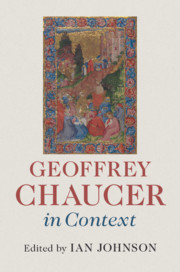Book contents
- Geoffrey Chaucer in Context
- Geoffrey Chaucer in Context
- Copyright page
- Contents
- Illustrations
- Contributors
- Abbreviations
- Introduction
- Part I Chaucer as Context
- Part II Books, Discourse and Traditions
- Part III Humans, the World and Beyond
- Part IV Culture, Learning and Disciplines
- Chapter 26 Childhood and Education
- Chapter 27 Philosophy
- Chapter 28 The Medieval Universe
- Chapter 29 Medicine and the Mortal Body
- Chapter 30 The Law
- Chapter 31 Art
- Chapter 32 Architecture
- Chapter 33 Heraldry, Heralds and Chaucer
- Part V Political and Social Contexts
- Part VI Chaucer Traditions
- Further Reading
- Index
Chapter 31 - Art
from Part IV - Culture, Learning and Disciplines
Published online by Cambridge University Press: 24 June 2019
- Geoffrey Chaucer in Context
- Geoffrey Chaucer in Context
- Copyright page
- Contents
- Illustrations
- Contributors
- Abbreviations
- Introduction
- Part I Chaucer as Context
- Part II Books, Discourse and Traditions
- Part III Humans, the World and Beyond
- Part IV Culture, Learning and Disciplines
- Chapter 26 Childhood and Education
- Chapter 27 Philosophy
- Chapter 28 The Medieval Universe
- Chapter 29 Medicine and the Mortal Body
- Chapter 30 The Law
- Chapter 31 Art
- Chapter 32 Architecture
- Chapter 33 Heraldry, Heralds and Chaucer
- Part V Political and Social Contexts
- Part VI Chaucer Traditions
- Further Reading
- Index
Summary
Later medieval art is usually discussed in terms of categories like architecture, sculpture, manuscript illumination, stained glass etc. While these categories have historical roots, medieval viewers naturally tended to conflate rather than anatomise what they saw: Chaucer’s testimony to the Court of Chivalry suggests this. Academic taxonomies of art are nevertheless valuable to scholars, even if the terminology of style associated with them is largely modern. Our understanding of later medieval art is clouded by vast material losses, although documents such as the inventories of Pleshy Castle (1397) and the abbot’s chapel at Bury St Edmunds (1429) offer some compensation. These reveal that taste for types of object and imagery was not generally conditioned by social status (e.g. lay or clerical). At the level of the common person, parish churches were major sites of display. Again, documents like the archdeacons’ inventories for the diocese of Norwich (1368) help fill in the gaps created by loss. Sepulchral monuments and architecture enjoy higher rates of survival and thus give a more concrete idea of the look, purpose and function of art.
- Type
- Chapter
- Information
- Geoffrey Chaucer in Context , pp. 266 - 272Publisher: Cambridge University PressPrint publication year: 2019

